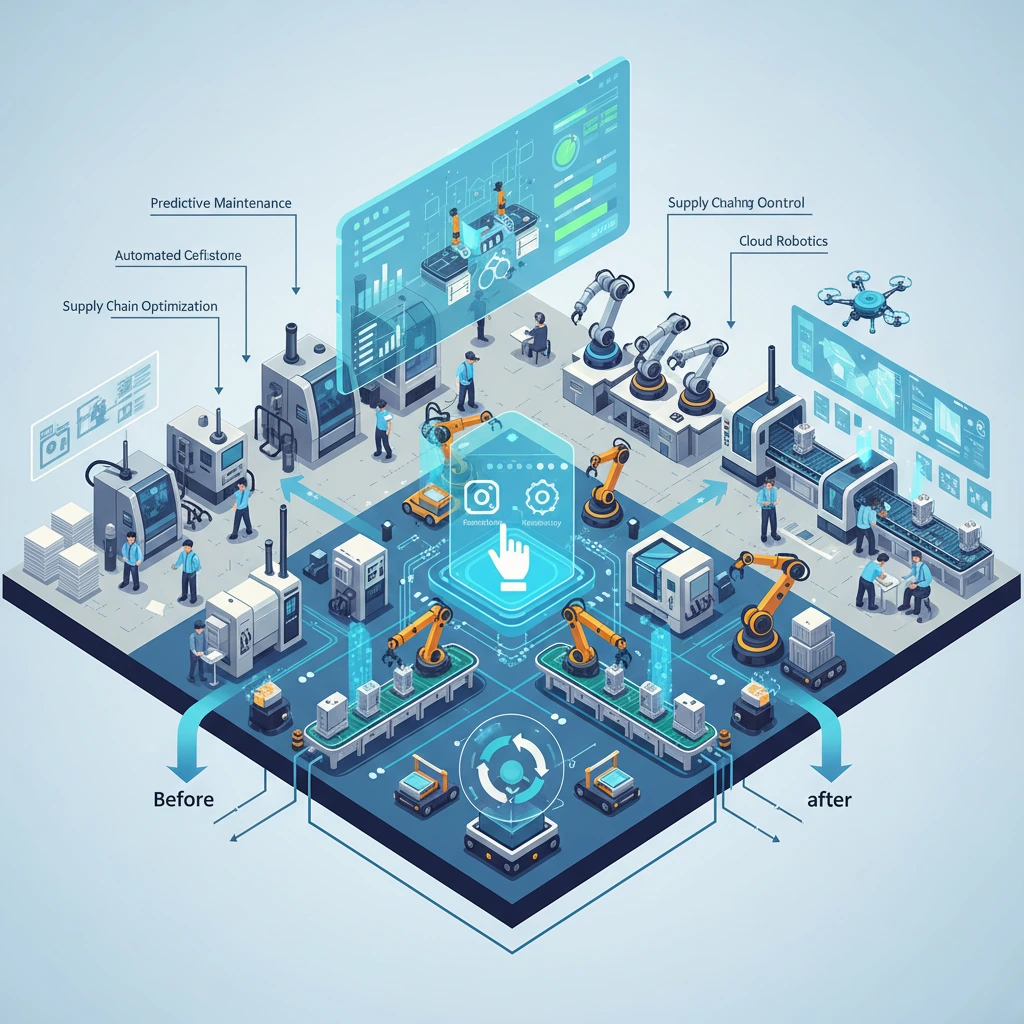The Fourth Industrial Revolution: How It’s Making Factories Smarter
For the longest time, the factory and the computer lived in different worlds. One was a place of steel, machinery, and physical products. The other was a virtual space of data and information. The industrial revolution and the digital revolution ran on separate tracks, each transforming our lives in its own way.
That separation is now ending.
The factory floor is finally connecting to the cloud. This powerful fusion of industrial machinery with smart, data-driven technology and augmented reality is what we call the Fourth Industrial Revolution, or Industry 4.0.
From a German Strategy to a Global Reality
The term "Industrie 4.0" originated in Germany around 2011. It was a high-tech national strategy designed to ensure the country's manufacturing dominance in a new digital age.
The goal was to move beyond the simple automation of the third industrial revolution and create systems that could intelligently manage themselves.
It's built on a few core technologies working in concert:
- The Industrial Internet of Things (IIoT) acts as the senses, with countless tiny sensors collecting real-time data on everything.
- Cloud computing provides the massive, scalable memory to store all of that information.
- And AI and Machine Learning serve as the brain, analyzing the data to find patterns and make smart decisions.
- Augmented and Virtual Reality (AR/VR) serve as the critical human interface for the smart factory, enabling immersive design, training, and even customer demonstrations.
How a Smart Factory Thinks
The real magic of Industry 4.0 technologies is their ability to be proactive instead of reactive.
Think about a traditional factory. When a critical machine fails, the production line grinds to a halt and a team rushes in to diagnose and fix the problem, losing valuable time and money. This is a purely reactive model.
Now, picture a smart factory. Sensors on that same machine are constantly monitoring its performance, detecting tiny fluctuations in temperature or vibration that are invisible to a human.
An AI algorithm, which has learned from months of data, recognizes these signals as the early warnings of a potential failure. It then automatically schedules maintenance during the next planned break.
The issue is solved before it ever has a chance to become a problem.
This proactive intelligence extends to the entire supply chain. Smart systems provide a crystal-clear view of everything, from raw materials leaving a supplier to the final product arriving at a customer's door.
This leads to smarter inventory and a supply chain that can pivot instantly when faced with a disruption.
How will Industry 4.0 Change the Future of Work in the Manufacturing Industry
The rise of the smart factory doesn't mean the end of human jobs. It means a fundamental change in what those jobs look like. The dangerous and repetitive tasks will increasingly be handled by advanced autonomous robots. This frees up human workers to focus on what people do best.
The future of manufacturing work is shifting from the assembly line to the control room.
There's a rapidly growing need for professionals and technical partners who can design and manage these incredibly complex systems.
Human work is evolving from physical labor to creative problem-solving and strategic oversight.
The Role of AR and VR: The Human Interface of Industry 4.0
Augmented Reality and Virtual Reality (AR/VR) are the key technologies that serve as the bridge between human operators and the digital factories of the fourth industrial revolution.
Here's how these technologies work in practice:
- AR and VR allows rapid design iteration and efficient prototyping.
- AR provides real-time, contextual information directly in a worker's line of sight, improving tasks like assembly, maintenance, and quality control.
- VR is used to create fully immersive digital twins of the factory floor. These virtual environments are perfect for training staff on complex machinery in a completely safe setting.
- AR and VR allow collaborative design and process simulation without any disruption to physical operations.
- 3D product visualization and AR overlays enables immersive demos for complex equipment and procedures, leading to more effective marketing and sales.
AR and VR plays a critical role in modern industries. Deploying these technologies can improve efficiency across the entire workflow, from the design phase to sales demonstrations.
As more industries and brands pivot to smart factories and embrace the fourth industrial revolution, immersive technologies are no longer a nice to have advantage. They are now central to efficiency and profitability.
Wondering how you can get started and deploy these technologies across your company?
Contact KiXR today to get started with immersive experiences.
By creating the high-fidelity 3D models, immersive AR applications, and interactive VR simulations that power these systems, KiXR provides the foundational tools to unlock the full potential of your workforce in the Industry 4.0 era.
Frequently Asked Questions (FAQs)
What is the role of Industry 4.0 in manufacturing?
The core role of Industry 4.0 is to create "smart factories." It uses data and connected technologies to make manufacturing more efficient, flexible, and sustainable. This allows for powerful new capabilities like predictive maintenance, real-time supply chain management, and creating highly personalized products at scale.
What are the 6 main applications of Industry 4.0 today?
While the applications are vast, six of the most common and impactful ones today are:
- Predictive Maintenance: Using AI to anticipate and fix machine failures before they happen.
- Supply Chain Optimization: Gaining a real-time, end-to-end view of logistics to improve efficiency.
- Autonomous Robots: Deploying smart robots for complex assembly, logistics, and material handling.
- Digital Twins: Creating detailed virtual models of products or entire factories for testing and simulation.
- Augmented Reality: Providing workers with digital information overlays for training, repairs, and quality control.
- Mass Customization: Allowing customers to personalize products that are then efficiently produced through automated systems.
Which country introduced the Industry 4.0 concept?
The term "Industrie 4.0" originally came from Germany. It was introduced by the German government in 2011 as part of a high-tech strategy to fully computerize the nation's manufacturing sector.
What is Industry 4.0 and what will it mean for developing countries?
For developing countries, Industry 4.0 presents a huge opportunity to leapfrog older technologies and establish modern, highly efficient manufacturing industries. This can attract significant foreign investment and create a new class of high-skilled jobs. However, it also comes with real challenges. Success requires major investment in digital infrastructure, a strong focus on upskilling the workforce for new technical roles, and implementing robust cybersecurity to protect these newly connected systems.
How does Industry 4.0 technology contribute to sustainable manufacturing?
Smart sensors and AI can monitor and optimize a factory's energy consumption in real time, which significantly reduces its carbon footprint. At the same time, using a digital twin helps conserve resources. By creating a detailed virtual simulation, a company can test and perfect a new process on a computer, which dramatically cuts down on the material waste that comes from physical prototyping.
Kavita has been adept at execution across start-ups since 2004. At KiKsAR Technologies, focusing on creating real life like shopping experiences for apparel and wearable accessories using AI, AR and 3D modeling


